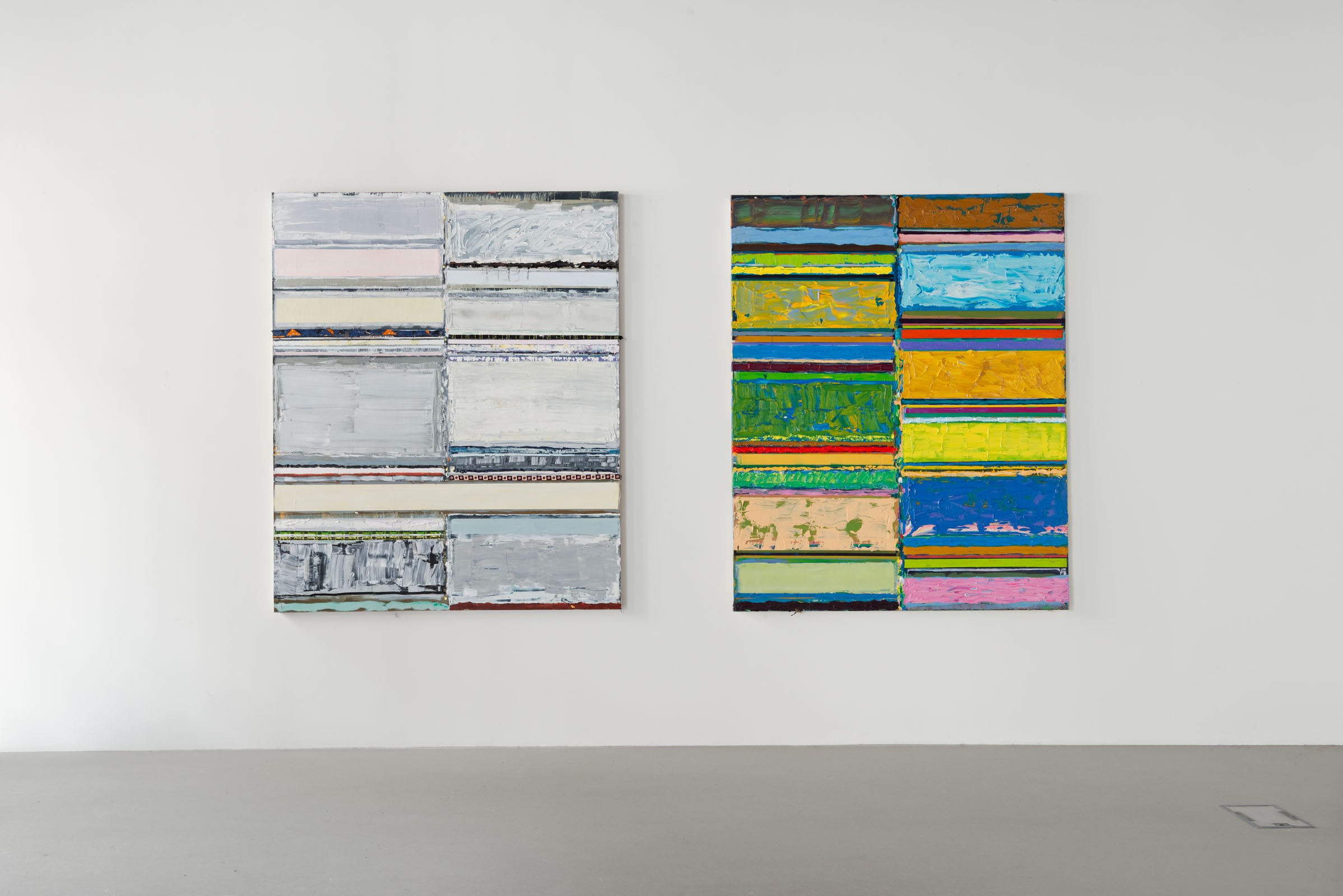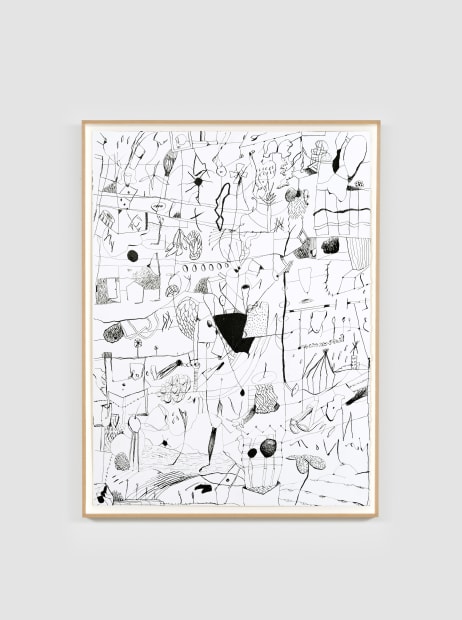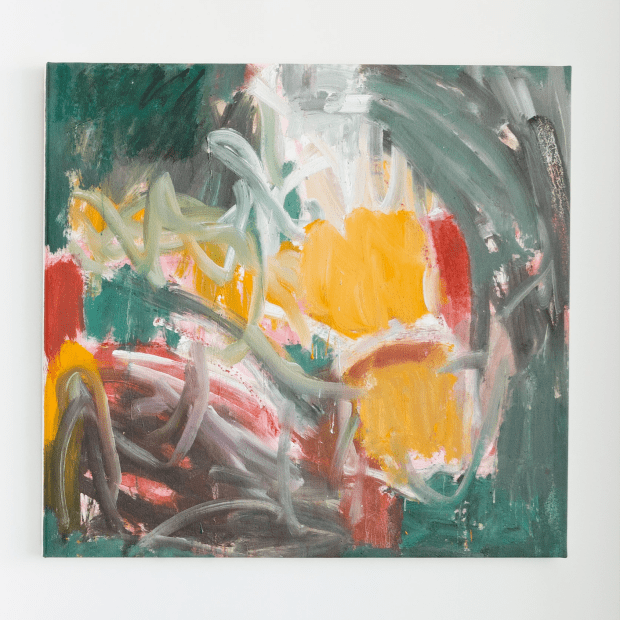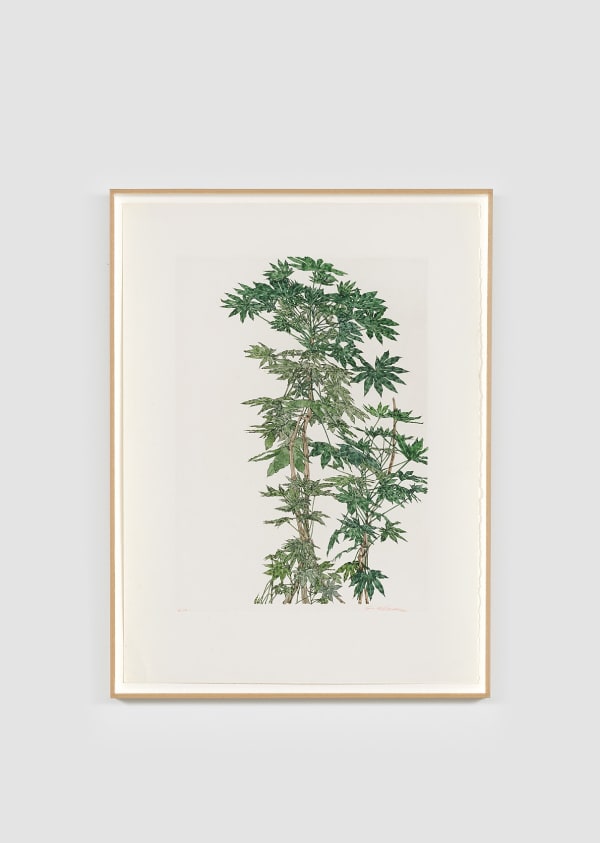Galerie Dutko is pleased to present at ART PARIS, from April 3rd to April 4th, 2024, an exhibition featuring major works by various artists from the gallery, combining paintings (Béatrice Casadesus, Monique Frydman, Christian Sorg, Lucas Talbotier, Max Wechsler, Vicky Colombet, Tegene Kunbi, Marek Szczesny), sculptures (Ted Larsen, Christian Jaccard, Vladimir Zbynosky), and works on paper (Jean-Pierre Pincemin, Jean-François Lacalmontie, Sam Szafran).
For any inquiries or questions, we can be reached during the duration of the fair at +33 6 82 87 40 72, or by email at galerie@dutko.com.
-
MONIQUE FRYDMAN
“I would like something like the Orée (dawn) of the world for my paintings.”
A major artist in abstract painting, Monique Frydman has often evoked the time of the paintwork and of the painting in her work. When does a work begin? At dawn (Orée), like something that is being born, is dilating, midway between desire and mastery. In the work of Monique Frydman, the issue always touches on the time of the paintwork, and the time of the painting. While this question was raised with the artist in 1988, it is still topical in her activity.
-
-
TED LARSEN
Ted Larsen (b. 1964, USA) is an internationally exhibiting artist and Pollock-Krasner Foundation recipient with a BA from Northern Arizona University. The work he creates supply commentary on minimalist belief systems and the ultimate importance of High Art practice. Since 2001, Larsen has used alternative and salvage materials in his studio exercises.
Ted Larsen's work has been exhibited widely in private foundations and museums in the US, including the New Mexico Museum of Art in Santa Fe, The Albuquerque Museum, The Amarillo Museum of Art, The Spiva Center for the Arts in Joplin, Missouri, and the Philadelphia Museum of Art as well as in over 100 gallery exhibitions.
-

-
BÉATRICE CASADESUS
Béatrice Casadesus draws viewers in with the tempo of her chromatic breathing, creating an impressive ballet of unintentional recollections that transport us to the gardens of the old wise man of Giverny, to the beaded focus of Georges Seurat, and to the sfumato of da Vinci.
Maurice Benhamou describes Béatrice Casadesus’s works as, “Free, floating, simmering, yet lightweight in gravity, [as] Nietzche might have said.” Béatrice Casadesus’s light often recalls August blue skies, as transparent as a Fra Angelico, made from goodness only knows what precious material. Turquoise perhaps.
-

-
TEGENE KUNBI
Living and working in Berlin, Tegene Kunbi is an Ethiopian artist born in 1980 in Addis Ababa, Ethiopia.
He obtained a degree in painting and art education from the School of Fine Arts at Addis Ababa University in 2004. In 2008, he left Ethiopia and continued his studies at the Universität der Künste Berlin, where he earned a Master of Fine Arts in 2011. In 2022, he was awarded the Grand Prix Léopold Sédar Senghor at the 14th edition of the Biennale of Contemporary African Art. Since then, he has been working in Berlin and has participated in numerous group and solo exhibitions in Germany and abroad.
-
 Untitled, 2023Huile sur toile / Oil on canvas200 x 165 cm / 78 3/4 x 65 inUntitled, 2023Huile sur toile / Oil on canvas200 x 165 cm / 78 3/4 x 65 in
Untitled, 2023Huile sur toile / Oil on canvas200 x 165 cm / 78 3/4 x 65 inUntitled, 2023Huile sur toile / Oil on canvas200 x 165 cm / 78 3/4 x 65 in -
VICKY COLOMBET
Living and working between Paris and New York, Vicky Colombet is a French American artist born in Paris in 1953.In the Hudson Valley, at the break of day, beneath a blue sun, amid a radiant summer, Vicky Colombet's artworks, showcased at Galerie Dutko, intertwine with the paths drawn by nature. Inviting light, materials, and the energy of the landscape to guide and shape her canvas, the artist embraces the rhythms of time, exploring in the studio the natural abstractions of life that inscribe the moment. Here, the motif is not the landscape that painters have long taken as their subject, but rather the means and the opportunity to immerse oneself in it, to explore the sensations it evokes outside the body, the subtle yet unmistakable resonances it induces. No horizon, no perspective, no escape. Vicky Colombet neither describes nor depicts. Her painting dissolves the motif to capture its minute essence and powerful magnitude. The canvas itself becomes nature and landscape, like a metaphor for the earth, terrestrial, celestial, vibrant, and fragile. -

-
JEAN-FRANÇOIS LACALMONTIE
Since the late 1970s, Jean-François Lacalmontie has been creating works that escape most traditional classifications. Initially, his work consisted of compulsively filling countless notebooks with thousands of signs on a daily basis. Sometimes evoking a kind of ideograms, neither entirely abstract nor completely figurative, these forms, these "things," these "objects" as he calls them, nourish a repertoire of shapes constituting his fundamental formal alphabet. Resembling a sort of writing without rational control, this process of distancing allows for an essentialization of the graphic gesture, whose haunting emergences question the conditions of the appearance of form.
-

-
CHRISTIAN SORG
Christian Sorg, born in Paris in 1941, is a French painter who lives and works in France. His training began at the Applied Arts, with a focus on sculpture. His journey continued at the National School of Fine Arts in Paris, where he developed his relationship with painting. Over the years, Christian Sorg has created a unique pictorial language of his own, in which he invents his method of appropriating reality.
Drawing from lived experiences, physically felt, Christian Sorg draws, paints, traces, and transposes onto canvas the strong presence of humanity's early days, the fragility of the world and the environment, the fleeting brilliance of life. Christian Sorg is a contemporary voice that reconnects with the most distant echoes.
-

-
LUCAS TALBOTIER
Lucas Talbotier was born in 1994 in Paris, France. After spending his childhood abroad in China and South Africa, he obtained a degree from the Beaux-Arts of Paris in 2018 and studied at the Rhode Island School of Design (USA) in 2017. He currently lives and works in Paris.
Lucas Talbotier's pictorial work revolves around a sensitive attention to the physical nature of light, arrangements of colors, and the balance of forms that are both simple and expressive. Behind an apparent abstraction, his paintings retain memories of landscapes. These works are memories, fragments of what remains of immaterial sensations. They are not about what one sees, but rather about the trace left by lived experiences.
-

-
MAX WECHSLER
The challenge for Max Wechsler is undoubtedly that of hiding what is readable. And yet, each one of his works is a book, a story to decipher in the maelstrom of his memory. Born in Berlin, he experienced the darkest hours of German history, his parents’ deportation, the unspeakable, what cannot be mentioned.
Max Wechsler was a graphic designer, a scribe, a copyist, he took possession of the written word, and by mixing the letters, smoothing the paper, he expressed in his work what cannot be spoken. He copies typographic writings and it is through the act of tearing and gluing back the paper that he “divests the word of its function”*. It is a question of speaking the unspeakable, of formulating the unsaid.
-

-
MAREK SZCZESNY
Szczesny's painting should not be approached from a purely formal angle. It primarily reflects a moral and ethical force, as well as a tragic grandeur, even in the least figurative pieces. Henri Focillon's formula "the hand makes the spirit, the spirit makes the hand" could have been invented for him. Indeed, Szczesny possesses a background world that may not necessarily surface in his consciousness, but which is expressed with each stroke of the brush. His imperiously drawn lines that overlap are enough to produce in the viewer an emotional shock akin to bewilderment. The large formats he favors certainly add to this tragic solemnity, as well as, in recent years, the reappearance of the human figure. This manifests in the form of a simple silhouette whose only outline is traced. This body, naively and poorly drawn, through its very emptiness, becomes the receptacle and projection of our existential anguish. Szczesny's Man is the innocent victim of all tragedies who addresses us with his silent cry. "What interests us," confirmed Picasso, "is the drama of man. The rest is false."
-

-
-
JEAN-PIERRE PINCEMIN
For Pincemin, engraving - like painting and sculpture - is about experimentation and cannot be confined to technique. Thus, a multitude of processes will be used, invented, and developed by the artist, in various workshops, in collaboration with printers such as Pasnic or Piero Crommelynck.
Pincemin has been regularly practicing engraving since 1985, with his first prints dating back to the late 1970s. "It was in 1979, thanks to the fortunate encounter with Jacques Putman, and his intention to publish what would one day be my engravings, that it entered my life." The Putmans publish engravings, sometimes in collaboration with Marie-Hélène Montenay. In the 1980s, the artist worked in Pasnic's workshop, using drypoint on plexiglass and large woodcuts made with a jackhammer and enhanced. During this period, his wife Françoise Pincemin also printed many engravings in her workshop in Authon-la-Plaine. A significant collaboration was then established with the Piero Crommelynck workshop, which produced beautiful sugar aquatints, in black and white, sometimes in color, notably thanks to the introduction of collaged papers.
-

-
CHRISTIAN JACCARD
For over five decades, Christian Jaccard has been developing a body of work exploring two key operations: knotting and burning. These paradigmatic "tools" serve him to express a way of conceiving things and, more broadly, his worldview. Philosophy, phenomenology, anthropology, and sciences are at the heart of the artist's aesthetic research. They permeate the various series of works with profound reflections on the principles of creation/deconstruction, notions of time and memory, and the origins and fundamental principles of art.
-
-
-
SAM SZAFRAN
The trajectory of Sam Szafran is unlike any other. As a child of a Polish Jewish family, he experienced the upheaval of a world and the collapse of childhood during the war. The practice of drawing and painting provided him with the grounding in reality that a life threatened by the dangers of history had denied him. As a self-taught artist hungry for knowledge, he stayed true to his creative path, secluded in his own universe. In the secrecy of the studio, Sam Szafran pursued the obsessions that fill his work without looking away. Setting aside the debates of his time, he chose figuration in a period that had either abandoned it or was heading in entirely different directions. A contemporary of the last avant-gardes, the painter kept himself apart while observing them closely, cultivating a taste for outdated techniques like pastel and watercolor.
In the late 1970s, Szafran began working with watercolor, a technique he initially used to enhance the engravings made at the studio of his friend Piero Crommelynck. Combining pastel and watercolor, achieving a synthesis between "dry and wet" as Degas had done before him, became a new challenge to which he dedicated himself particularly in his series of plants.
-
-
VLADIMIR ZBYNOVSKY
Light and time are the major concepts in Vladimir Zbynovsky's artistic exploration. Through its physical principles, light prompts him toward existential meditation, generating works that bear witness to both the transformation of matter and human transience. From the outset, his work questions: What is time? What propels it? These questions naturally lead to reflections on the birth of matter. Hence the desire to bring together two different materials, both evoking the birth of the universe: stone and glass, the medium of light.
His works, with evocative titles, reveal a quest for matter at the boundaries of the spiritual. They remind us that the universe has its own life, not conditioned by the appearance or disappearance of humans, that life is a broader principle than what we reduce it to, and that light is a vital energy beyond comparison. Thus, the artist employs all the tricks of his art to transform his sculptures into points of passage from one dimension to another, like altars connecting the earthly world to a beyond. Hence, it was not surprising to see him entrusted with the creation of a new altar for the Basilica of Saint-Denis. Light calls forth light.
-















